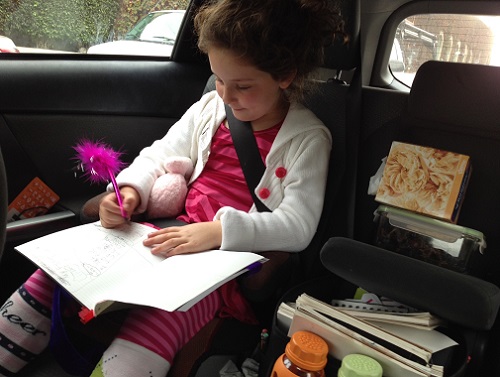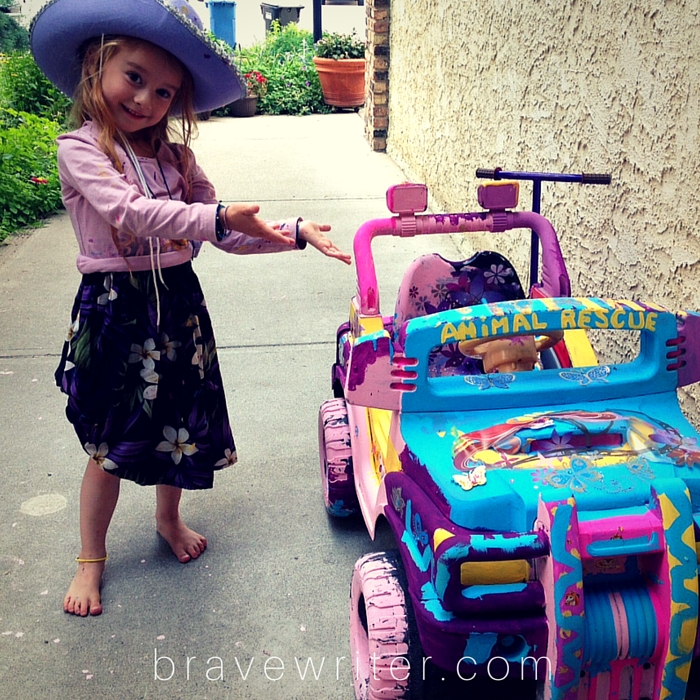Once you’ve started homeschooling in earnest and have “applied the method” faithfully, a bump in the road will inevitably occur. Even if your kids are cooperating happily with your best executed plans and philosophy, you will still hit a bump at some point in your homeschooling career. The “Oops, here’s a bump!” moment is as inevitable as Cheerios thrown from a high chair.
The “bump” can come in a variety of shapes:
- One morning, after weeks of successful implementation of the homeschool “schedule,” one of your children will awaken to say, “I hate my life.”
- You realize mid-workbook that you don’t actually agree with the material (how it’s presented, its content, the style of the curriculum, the philosophy behind it, or workbooks period).
- Your confidence has grown and you feel less willing to delegate your days to a pre-fab schedule.
- Alternatively, you may be the parent who now feels a little at loose ends after a lifestyle of no schedule or obvious structure. You wish you could measure your days or years in a way that tells you that you are being successful; you want a routine or tool to help you monitor progress.
- Your oldest child has hit “that age” (the one that you see as more “officially” significant than earlier ages). This “age” varies family to family, but can induce panic and re-evaluation as early as 4th grade (the “it all counts” moment of elementary school), or at the beginning of the junior high years, and most especially at the start of high school. “That age” causes the homeschooling parent to doubt the successes of the past, looking for the next new, right education process that will be more effective and more preparatory for academic life. (Some people address the “it all counts” moment with heavier-handed academics, while a surprising number opt out completely—going the route of unschooling or student-led learning as a way to ward off the cultural pressure to “do school”).
- Conflict between siblings escalates. A desire to create space between children of differing maturity levels grows.
- Online discussion groups, books, and homeschooling friends make you aware of options you didn’t know existed. You are drawn to a philosophy of education that better suits your personality and educational vision.
- The vaunted tool isn’t working. Now, after consistent implementation, you have enough evidence to know it. Time to “switch it up.”
Any of these “bumps” can create the shift that takes you from “Applying the Method” to the “Switch it Up!” moment.
The most common way to address the bump is to switch – to change programs, systems, or philosophies. Many times this change is warranted and becomes a life-giving source of “new”!
Experimentation feels liberating. The new philosophy provides a rich contrast to the previous way of learning, and so jump starts the languishing methodology. In fact, often a fusion occurs where the best of what worked is retained while an injection of “new” creates refreshed momentum and optimism.
The “Switch it Up!” stage can last a good while. In the initial months and years, this stage of development is when the homeschool feels the most life-giving for everyone (parent and children). Often there are no high schoolers yet (though some parents who start homeschooling later go through this same set of steps, but tailored to high school characteristics).
During this stage, experimentation is king. It’s rare that the homeschooling parent replaces one system for another exclusively (though it does happen sometimes). Mostly, though, the homeschooling parent in this stage is creating a mosaic of learning, testing and trying a variety of ideas—sifting philosophies—to see which works best for which kids and for the parent.
It’s as though the home becomes a laboratory for learning. The parent is more tuned into the children and less beholden to the program. Together, they exchange their ideas; the feedback from kids to parents is valued. Adaptation ensues (even child to child).
A “one-size fits all” system is no longer trusted.
The benefits of this stage are immense. Research into learning feels productive, optimism that your children will learn stays relatively high, your energy is still available to you.
The dangers of this stage of development are as follows:
- Too many switches! Once you invite change into your home, sometimes she moves in for good. Suddenly you doubt your choices over and over again, bouncing back and forth between philosophies. “If this choice was better than that one, could there be an “even better” choice somewhere else?”
- The temptation to “apply the method” to the new educational style is strong. The homeschool parent still often believes that the promised results are only guaranteed if the new vision is applied scrupulously (from unschooling to K-12).
- Big shifts in practice and philosophy can disorient children. To go from a methodology that uses workbooks and a predictable routine to a sudden absence of all schoolish materials can be frightening. Conversely, moving from unschooled freedom to a text book with tests and grades can feel like an invalidation of all those previous years, and so the child now feels “behind.”
- The process of research is oftentimes more interesting to the homeschool parent than implementation. Research (done rigorously and thoroughly) doesn’t translate into energy spent learning how to follow through once the products are purchased (reading the instructions, taking time to plan for success) or philosophy adopted (imagining it practically in a day-to-day life). Even an educational vision like unschooling reads better online than it is often lived in a home, where the parent doesn’t fully grasp the act of strewing or the parent-investment in the child-led learning process.
The “Switch it Up!” stage can be invigorating and empowering for the now-skilled homeschool parent. It’s a necessary period of adjustment and adaptation to the reality of your family and your own personality. Parents act with more confidence in how they select educational tools and how they structure their days.
As long as the parent is careful not to overdo the curriculum swapping, and puts as much energy into envisioning the implementation as s/he did in the “research-conversation-with-friends” part of the journey, wonderful newness of life and educational energy follow, in most cases…
…until you hit the “It Doesn’t Work” stage.
Also, here are stages One and Two, if you missed them.
Cross-posted on facebook.




















